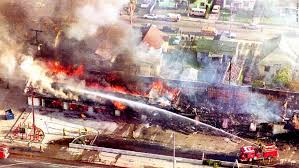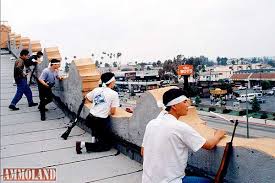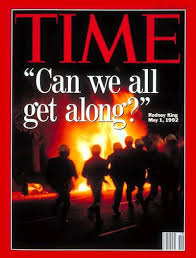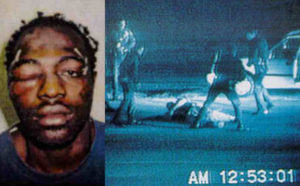My Eyewitness Account: 25 Year Anniversary of LA Riots, an Insurrection Which Effected the OJ Simpson Trial Years Later
 I can’t believe it’s been twenty-five years since the LA Riots, or as I like to call it, the LA Insurrection.
I can’t believe it’s been twenty-five years since the LA Riots, or as I like to call it, the LA Insurrection.
It seems as if it was only a few years ago that I was watching this city slowly ignite; from the Rodney King videotaped beating by the LAPD, the subsequent not guilty verdict, to the execution of a teenager (Latasha Harlins) by a Korean store owner, (shot in the back of the head), to finally, the rebellion.
This post is not to say what happened during those days and nights that destroyed over a billion dollars in property and took the lives of sixty-some people, was right… but some may find it justified. Why do I say that? Because when people have no resources and feel that justice does not pertain to them, they feel they have no other recourse.
Although the riots were a manifestation of systemic racism within the rank and file, it ballooned into a violent reenactment of the 1965 Watts/Los Angeles riots, and served as an opportunity for unscrupulous individuals to seize the opportunity. Both riots stemmed from police racism and violence against minority communities as a whole, which remained unchecked until the rebellion.
In my book, MY LIFE DURING THE OJ SIMPSON TRIAL, I explain, in my opinion, why the city burned. I was actually at the epicenter of the rebellion; right where it started.
Below is a quote from my book:
I never considered myself an activist, but I knew I couldn’t just stand by and accept the (Rodney King) verdict without reservation.
My sister also lived in Los Angeles at the time. We heard about a well-known church that had decided to hold a community meeting on what was next. I thought this was the best way to show my support against police brutality and connect with peaceful, like-minded individuals.
My sister and I drove to the church and parked a few blocks away as thousands converged on the church. We were a frustrated and perhaps disillusioned group hoping to come up with a plan for a demonstration, or the like. Although the church held several thousand people, it quickly overflowed outside and onto the sidewalks.
We waited outside and listened to the speakers, who were church officials and politicians. To tell you the truth, I don’t remember what was said, only that the meeting went on for several hours with no real steps laid out at that time for us to follow.
My sister and I walked away, even more frustrated. A few moments later, someone decided to start a march. I don’t remember who, but everyone pouring out of the church joined the peaceful march on the nearby streets.
But shortly afterward, a few individuals splintered off from the main group, shouting with anger and resentment. One person picked up a rock and threw it at a nearby store window, and others followed.
My sister and I were there to march peacefully, to demonstrate our determination to draw attention to a broken system. Those sentiments, I believe, were shared by most who attended.
However, sometimes, after you’ve reached your breaking point, you lash out. And that is exactly what a few individuals did during the march. Marching was not enough of an outlet to contain or dissipate their built-up anger from years of police misconduct. This was the beginning of the LA Riots/Rebellion.
You may have seen the infamous beating of Rodney King by a few LAPD officers, while over ten officers stood nearby and watched. If not, you can watch it here.
This was at a time when no one had pocket cell phones to capture such things. The cameraman, George Holiday, happened to have a handycam and heard the scuffle outside. He grabbed his camera and stood out on his balcony. He pushed the record button.
Who was Rodney King?
Rodney King was a motorist who the LAPD had pulled over for speeding. There was a high-speed chase (slow by today’s standards) and he finally pulled over. As soon as he stepped out of his vehicle, the assault began.
Just how badly was he beaten? Many have no idea to the extent of the injuries that affected him for the rest of his life. In fact, one of the officers bragged that he hadn’t “beaten anyone this bad in a long time.” (Associated Press, 1991).
Again in my book, I go into further details:
“Fifteen or more Los Angeles Police Officers pummeled and hogtied a black man after a traffic stop. He was Tased, handcuffed, and left bleeding on the side of the road from multiple kicks and stomps by steel-booted officers. Fifty-six baton swings landed on Rodney King’s skull, arms, spine, and legs. They continued the torture even after he lay lifeless on the ground. When it was over, they tossed him into an ambulance. The assault lasted several minutes with over fifteen officers participating in some fashion, or simply watching without reacting.”
Before it was known that there was videotaped evidence of the assault, officers filed reports stating that Rodney King lunged at them; tried to attack them and grab their guns. Why does this sound so familiar?
They filed false reports, which were submitted as evidence in their criminal trial. So, in case you didn’t follow the trial, (or weren’t born yet); all the officers were found NOT GUILTY.
It was shortly after, that the insurrection/riots broke out, and where Rodney King went on live television and uttered his now famous phrase, “Can’t we all just get along?” 
Next, the city saw another videotape from March 1991; store surveillance of a young black teen, Latasha Harlins, tossed something on the counter at a Korean convenience store; no doubt angry about something. As she turned and walked out of the store, the owner, Soon Ja Du (Hangul: 두순자), pointed her pistol and shot Latasha in the back of the head.
What did the jury do in this case? They came back with a guilty verdict and recommended sixteen years, the maximum sentence. However, Judge Joyce Karlin didn’t accept the jury’s sentencing recommendation and instead sentenced Du to five years of probation, 400 hours of community service, and a $500 fine.
These two major tremors, along with a steady stream of under-reported tremors lead to the insurrection twenty-five years ago.
So what do these events have in common with the O.J. Simpson case?
Again, from my book, MY LIFE DURING THE O.J. SIMPSON TRIAL:
Riding on the coattails of Rodney and Latasha, was a man, a celebrity given mythical status; a man who had broken through racial barriers, a hero to many people of all races, handsome and strong… and accused of two heinous murders.
So what have we learned, if anything, from the 1992 rebellion? That a steady stream of injustices can add up to the one straw that breaks the camel’s back.


